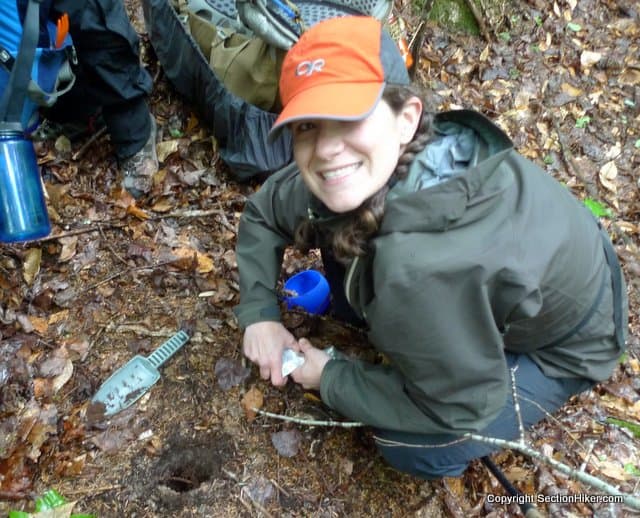If you need to take a poop on a hike and you’re not near a composting privy or toilet, it is recommended that you bury your poop in a cathole so that it can biodegrade, animals won’t dig it up, and it won’t disturb other visitors.
You’d think everyone knew how to dig a cathole to bury their poop, but it’s surprisingly hard to do in certain soil types.
Note: If you’re a Leave No Trace Trainer, there’s a copy of the Cathole Lesson Plan I prepared for this exercise at the end of this post. The pine cones worked really well as fake poop.
Cathole Size
In most locations, dig a cathole 6-8 inches deep and 4-6 inches in diameter. This can be difficult if the soil is full of rocks and roots like it is in New England, so give yourself a little extra time to find a good spot to dig. It might take you a few tries. In air or desert conditions, dig a cathole 4-6 inches deep and 4-6 inches in diameter.
Where to Dig a Cathole
When digging a cathole, select an inconspicuous site at least 200 feet (70 steps) from the nearest trail, campsite, or water source, including streams, rivers, ponds, and lakes. The best sites have deep organic soil with a dark rich color and good exposure to sunlight to aid in decomposition. Avoid areas with water runoff, particularly above water sources, which might erode your cathole and carry your waste into the local water supply. If you are camping with a large group or for an extended time, make sure to widely disperse everyone’s cathole locations, and use a single cathole for each poop.
Toilet Paper, Wet Wipes, and Tampons
It’s always best to pack out used toilet paper so that animals don’t dig it up and spread it around the area. Use as little as possible and store the used sheets in 2 or 3 Ziploc bags to prevent leakage. Stick to plain, unperfumed toilet paper and hang your waste at night to avoid attracting animal scavengers. If local regulations or practice enables burying toilet paper, make sure to bury it at the bottom of the cathole.
Wet wipes, tampons, and all other hygiene products should always be packed out with you and disposed of when you get back to civilization. To minimize smells in the Ziplocs, mix the waste paper with crushed aspirin.
Burial
After you finish your business, bury your waste with the toilet paper on the bottom of the hole. Fill the cathole with the original soil you dug up and disguise it with leave little and forest duff.
Urinating
When urinating, pee on rocks, gravel, or mineral soil instead of vegetation. This will protect plans from being chewed on by animals looking for salt.
Best Trowels
When digging in earth that is full of rocks or roots, it’s best to have a sturdy trowel with serrated edges. One of the most economic trowels available is the GSI Outdoors Cathole Sanitation Trowel. The GSI is great because it’s lightweight, has inch long measurements embossed on it, and serrated edges to cut through roots and compacted soil. An MSR Blizzard Tent Stake also works fairly well but is more prone to bending. Boot heels make poor digging tools in soil filled with rocks and roots.

Leave No Trace Lesson Plan – How to Dig a Cathole
Objective
Materials Needed
- 5 GSI trowels. Students should have brought trowels or other digging tools, but most probably didn’t
- A shopping bag full of pine cones to simulate poop. These should be collected ahead of time.
Scenario Preparation
- Find an open but wooded site, off-trail. Doesn’t have to be 200 feet in since we won’t be burying actual waste.
- Count off into 2 person teams, mixing backpacking participants and trip leaders
- Hand out three pine cones to each group
- Hand out 5 extra GSI trowels in case students/leaders did not bring their own or want to try something different
Presentation
- Explain the need to minimize impact on plants and animals, do not change their behavior, keep them wild, and preserve the experience for others to enjoy
- Pee on rocks or mineral soil and not vegetation because animals will chew them to get at the salt.
- Solid waste disposal using catholes
- Placement: 200 feet off trail, campsite, or water source (70 steps), and out of the way of water runoff
- Cathole dimensions: 6 to 8 inches deep, 4-6 inches in diameter, mix ingredients with a stick, cover with organic matter, not rock, and disguise with natural materials
- Toilet paper goes in first, then poo. Alternatively, pack toilet paper out.
- Feminine products and wet wipes must be hung at night and packed out.
- Start digging
- Call out when your hole is completed
- Instructor to measure depth and dimensions
- Bury your poo and disguise site.
- 10 minutes maximum digging time, then recall groups
Group Debrief
- What did this experience show you?
- How hard is it to dig a cathole?
- How much time does it take?
- How do different tools – tent stakes, etc, compare to a trowel?
 SectionHiker.com Backpacking Gear Reviews and FAQs
SectionHiker.com Backpacking Gear Reviews and FAQs 